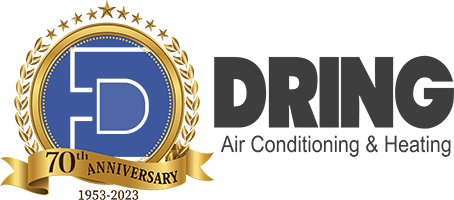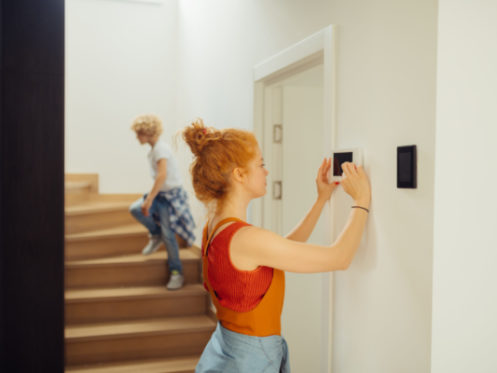Most of the information displayed on a modern thermostat’s touchscreen is easy to interpret. Cool, warm, auto, and fan are a few examples of what you may see on the display. But have you ever seen the words recovery mode on your thermostat’s touchscreen? Discover what recovery mode is along with some reasons why your thermostat switches into this mode.
What Is Recovery Mode?
The first thing to know about a thermostat’s recovery mode is it immediately follows energy-saving mode. They work as a pair. When looking at the recovery mode, it helps to explain it with a simple scenario.
After everyone leaves for school or work in the morning, a home’s smart thermostat senses a lack of movement in the space. Consequently, the thermostat clicks into energy-saving mode. This allows the thermostat to adjust to a lower or higher temperature instead of the preferred setting. No one is at home, so the atmosphere can be a little cooler or warmer than usual. This mode prevents an HVAC system from expending a lot of energy to warm or cool an empty home. As a note, the temperature should still be comfortable enough to care for any pets in the house.
Family members begin to return to this example household at around 2 p.m. The homeowner programs the thermostat accordingly. The thermostat clicks into recovery mode at 1 p.m. so it can recover from energy-saving mode and reach the homeowner’s set temperature by 2 p.m. The recovery mode allows a homeowner to walk into a home that has already achieved the preferred temperature. After recovery mode shuts off, the thermostat works to maintain the preferred temperature.
Why Is Your Thermostat in Recovery Mode?
One reason is you’ve set the thermostat to go into this mode. On many thermostats, you can enable or disable the recovery mode. However, recovery mode can sometimes kick in even if you don’t program your thermostat.
A thermostat can slip into recovery mode due to a power outage that disrupts your programmed temperature settings. If you don’t have a battery backup, the temporary power outage may erase all of your settings so the thermostat defaults back to recovery mode. If you do have a backup, then the thermostat will work to return you to your scheduled temperature.
Damage to electrical wiring is another reason your thermostat may go into recovery mode. The damage is affecting the settings.
Can You Stop Your Thermostat from Going into Recovery Mode?
It may be possible to stop your thermostat from moving into recovery mode. It depends on the capabilities of your particular thermostat.
Access the “Settings” option on your thermostat’s menu. Some thermostats allow you to disable the recovery mode, so it won’t come on at any time. If you’re not sure how to do this, check the thermostat manufacturer’s manual. Also, a skilled HVAC technician can let you know if you can disable your thermostat’s recovery mode and show you how.
Can Recovery Mode on a Thermostat Signal a Problem?
Sometimes recovery mode can signal a problem with an HVAC system. If a system moves into recovery mode and stays there, it can mean that the system isn’t working as it should. If this happens, it’s best to contact an HVAC pro to check the condition of the thermostat. An HVAC technician has the tools and equipment to fully evaluate a thermostat to determine the issue.
What Are the Benefits of Recovery Mode?
One of the benefits of enabling the recovery mode on your thermostat is an increased level of comfort. As an example, say you program your thermostat to register a comfortable 70 degrees Fahrenheit at 6 p.m. every day. With recovery mode, you will be able to enjoy walking into a home registering 70 degrees at 6 p.m. You don’t have to wait for your system to reach your preferred temperature after you get home.
Recovery mode helps to make your HVAC system more energy efficient. If you and your family forget to program the thermostat before leaving the house, the energy-saving and recovery modes prevent your system from working overtime to warm or cool an empty home.
Is It Worth Getting a Thermostat With Recovery Mode?
The answer to this question depends on your preferences and the energy needs of your household. If you like the idea of having a smart thermostat that you can program to suit your temperature preferences, then it’s worth it. You can program this thermostat long-term or on a daily basis. Plus, if you want a thermostat designed to save energy especially when your home is empty, then a smart thermostat is an excellent choice.
Many smart thermostats can be controlled remotely via an app. So, if you want to adjust the temperature in your home while you’re at work, school, or even on vacation, you have the option. This is appealing to people who like being able to control their heating and cooling systems from anywhere.
A smart thermostat gives you a lot more options than a traditional model when it comes to monitoring the temperature inside your home. You may even be able to control the temperature in different areas of your house depending on the capabilities of your thermostat.
Alternatively, if you prefer a thermostat that you must adjust every time you want a temperature change, then a traditional thermostat is a good option. Traditional thermostats with a dial control are easy for anyone to adjust. Though traditional models are a low-tech option, it doesn’t make them any less reliable than other types of thermostats. As long as a thermostat and the HVAC system that it’s connected to receive regular maintenance by an HVAC technician, you can rely on it to serve your household.
Your Full-service HVAC Professionals
Dring Air Conditioning & Heating is proud to serve the HVAC needs of residents in Carrollton and the surrounding area. Are you thinking about updating your thermostat to a programmable model? If so, our knowledgeable HVAC technicians can show you all of the benefits. We take the time to explain how your new thermostat works, including providing information on all of the available modes — even recovery mode! If you want another type of thermostat, we can show you all of the available options.
In addition, our business provides first-rate heating and cooling repairs, installations, and maintenance services. Do you need help with your indoor air quality? Poor air quality can indicate the presence of mold, bacteria, and other harmful contaminants inside your home. Unfortunately, it can aggravate coughing, sneezing, and other symptoms in family members with respiratory illnesses. Our trained technicians can repair, seal, and replace air ducts to boost the quality of your home’s air. Also, we offer air purification products, humidifiers, dehumidifiers, UV lights, and more. We can help you find a solution to poor indoor air quality. Since 1953, Dring Air Conditioning & Heating has nurtured a reputation for excellent customer service and dependable work. We’re pleased to have an A+ rating with the Better Business Bureau.
For professional thermostat installation, repair, and maintenance service, give our friendly staff at Dring Air Conditioning & Heating a call today!







